#Bridal Headwear
Explore tagged Tumblr posts
Link

vintage net mini length bridal veil
0 notes
Note
“just the tip” turing into “i know you can take it just a few more rounds” with kinich? im totally normal about this man i promise 🙂↕️
7 rounds, with a side of coffee please!
nsfw utc, marathon sex if u squint, sex mention + the morning after, usage of 'cunt' but think of this how u want (I don't specify pronouns), praise kink, mentions of blindfold/rope (not the main point), shower sex somewhat (again not the main point)
wc: ~0.9k. artwork belongs to @/leisomnium on x, go check out their page.

he promised you it'd be just his tip snug inside your cunt. why are his thrusts soo mean now! (you asked for it)
all happening right after a celebration party mualani throws- she offers you two a house to share before going home. (three-day celebration in which you both do it on the third day)
he said he'd be gentle, that was four rounds ago. it felt as if he was losing his sanity inside you (literally), and he only wanted more.
the coos, and whispers against the shell of your ear- fuck you couldn't help but get turned on. he could feel the hefty amount of essence, and wetness on his shaft, as it spread everywhere.
the different speeds you could observe throughout the seven separate rounds you both underwent, he was rougher in the middle- vanilla towards the end.
spending the first few hours letting your tight cunt get used to his girth and length. fuck it was already the morning after but it's as if it was still there, your legs trembling at the thought.
he loved how loud you were last night though, he could hear the sounds of animals nearby getting startled. and a knock on the door from a neighbor, haha.
he was against the idea of tying you down to the bed or blindfolding you at first. but he will give in if you ask nicely, say please :)
he prefers he handles you himself, your skin on his, nothing in between. but it definitely would help him out by not needing to hold you down. the only times he does do it on his own when you don't ask is when you've been a little more than just 'bad'.
his tattoos glow a little when he gets pleasured, so in a way, you get clues on your own when you rode him, which spot he preferred inside you, or which position he preferred... (it was cowgirl by the way)
his hands cause marks on your skin, and he genuinely feels bad. he always offers help to cover them by wrapping his jacket around your waist or making his headwear into a scarf to cover up the hickeys on your nape.
yet you couldn't discard the feeling of the previous night. would always remind you whenever you tried to move the next. using nearby objects for support 'till kinich noticed, and wrapped your arm around his neck instead to support you, or full-on bridal style, whatever you want.
how he whispered "don't worry, let's just get you to the bed" sounded so familiar to the tone he used yesterday to tell you how good you took his cock inside you. about how deep it was... or how he'd fill you up to your very brim. "not a drop wasted." word for word.
"i know you can take it for a lil' longer, sweetheart... c'mon..." is all you heard in the moment as his godly speed along with merciless thrusts ironically enough. his mouth lusted praise into your hears, while his dick said much else.
he spent a few rounds thinking about what position he wanted to fuck you in the most. but he was stuck between his top three; missionary, mating press, and cowgirl. he couldn't decide but doggy style was a close second.
he much preferred a position in which he could stare at your features when doing so. like missionary- he could lean in to kiss your sweaty forehead, and hold your hips close to his as he repeatedly slammed himself inside.
or mating press where he could get a pretty lil' close-up of your face, he could feel your legs get tired while he trusted inside though, and honestly felt bad, that's when he started slowing down. instead of the ruthless pounding, he'd be a regular to grinded his angry red tip against your g-spot in hopes it's just as pleasurable as the previous feeling.
maybe it was cowgirl, wherein you'd do all the work. and he could watch how good your cunt swallows him whole, or how your head threw back in pleasure because of his cock. nothing turned him on more than your own expression. gosh, he could already feel himself harden at the sudden thought of it.
honestly would be the same for reverse cowgirl but if he were going to be real with you- he'd rather watch your expression range from your eyes rolling to the back of your head rather than for those beautiful faces you make be faced away from him. he could care less about seeing how you take it from behind somewhat.
it was the sixth round in which you remembered he was the loudest in, and in all honesty, it wasn't even supposed to go up 'till seven rounds. but you looked just so.. appetizing in your bathrobe. the fact you trust him so much enough to shower with him, he still blushed at the thought even when you've been together for about three years now.
he could feel his orgasm build up again as he pinned you to the wall of the steamy hot springs. shit, he knows mualani would get mad; having to clean the pool again but he couldn't help but release on your back as it arched, you both climaxing together.
maybe he did have a favorite though, and it didn't necessarily concern his shaft rubbing against you this time.
the way you tasted definitely changed his point of view on intercourse. damn did it taste better than any meat stew he's eaten and made before!
but how could he not? you forgot your last pair of clothing for the night, having to borrow his and fuck. he's turned on again from the sight of you in his clothing.
too late to realize when he already lifted the shirt up a little to seep his tongue into your hole. fingers already working over your clit, making sure you feel everything.
oh he knew how much you liked when he hummed in response to your little whimpers to turn them into moans, and whines. of his name? of course!
you tasted nice, especially when your gummy walls clenched around his fingers as they interchanged positions with his tongue, he landed pretty little kitty licks onto your clit. he added another digit up into your entrance as they curled riiiiight theeeree...
flashback over, the night was done and dawn arrived as kinich decided on just carrying you bridal style home using his rope to quickly travel back instead of using mualani's koholasaurus like previously done (took two days to arrive LOL).
mualani arrived at the hot springs near to the home she lent you both to, cookies and milk in hand. "man.. i didn't even get to say goodby- is that.. white in the water.. KINIIIIIIIIICH!!!"

#──── resin: performances#genshin impact x reader#genshin drabbles#genshin headcanons#genshin fanfic#genshin x reader#genshin impact scenarios#genshin impact imagines#genshin smut#genshin impact#genshin imagines#genshin impact fanfiction#genshin impact smut#genshin impact x you#genshin x female reader#genshin x gn reader#genshin x you#kinich smut#kinich x reader smut#kinich x reader#genshin impact kinich#genshin kinich#kinich#kinich x y/n#kinich x you#natlan x reader#smut#xreader#smutx reader#smut x reader
2K notes
·
View notes
Note
Hi my friend wanted to ask about Chinese Opera and the red pom poms on their hats and their significance. I asked my mom and she said they were for decoration so I just wanted clarification
Hi! Thanks for the question, and sorry for taking ages to reply!
The pom poms you see on 盔头/kuitou (Chinese opera headdresses) are called 绒球/rongqiu (lit. "velvet ball"). They are often red, but can also be other colors, and vary in size. Rongqiu are decorative and serve to distinguish the many different types of kuitou from one another. Each type of kuitou is distinct in the number, size, and color of rongqiu that it's decorated with (of course, not all kuitou have rongqiu).
Below - a few different types of Beijing opera kuitou decorated with rongqiu (x):

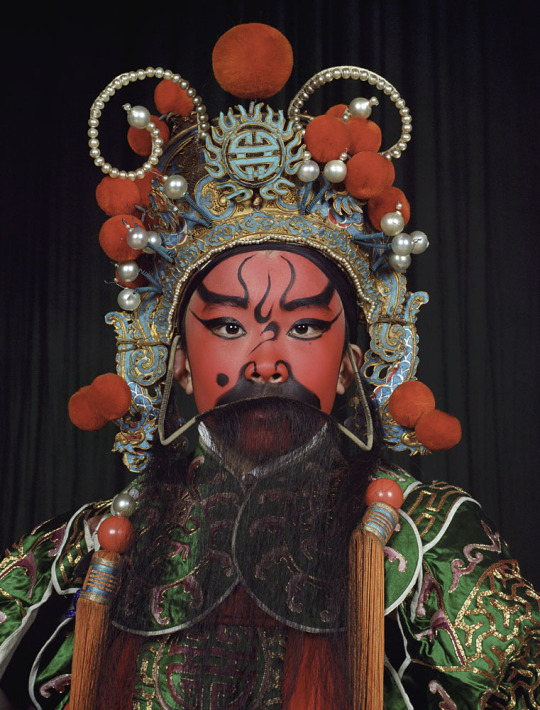
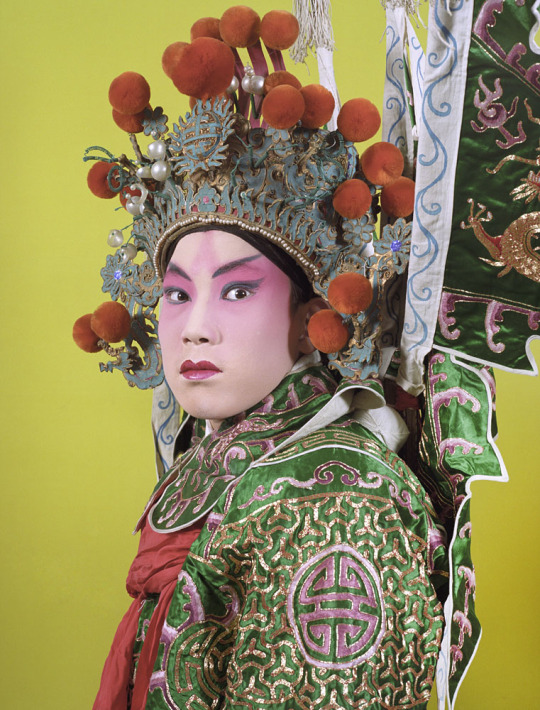
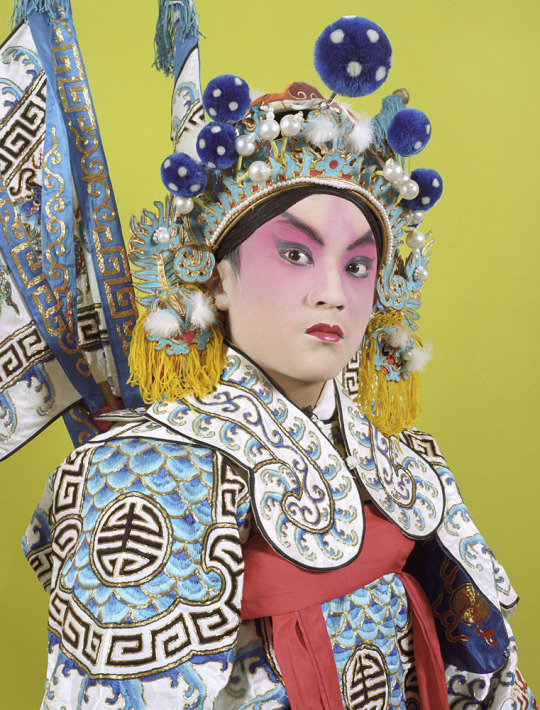

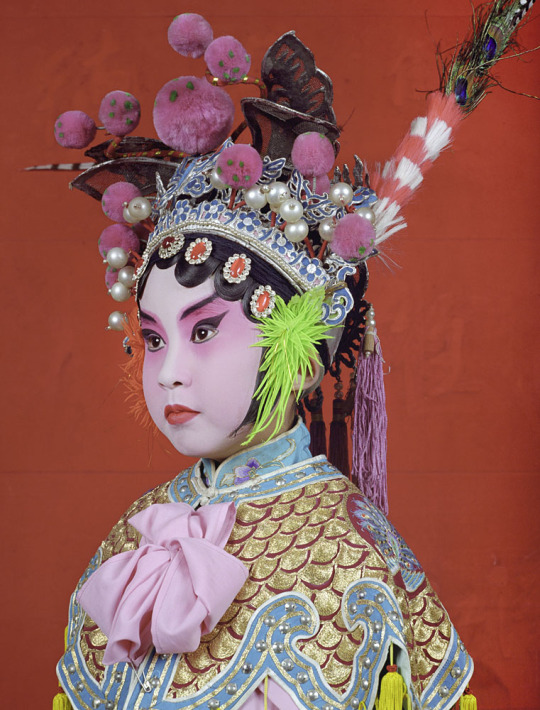
Rongqiu isn't used just for Chinese opera performances - it's a very common decorative item for Chinese headwear, especially for traditional/folk performances.
Below - examples of rongqiu use in folk custom/performance costumes, left to right: 1) 游神/youshen (wandering gods) procession in Fujian (x), 2) 英歌舞/yingge wu (yingge dance) performer in Guangdong (x), 3) & 4) 高跷/gaoqiao (stilt walking) performers in a 社火/shehuo parade in Gansu (x):

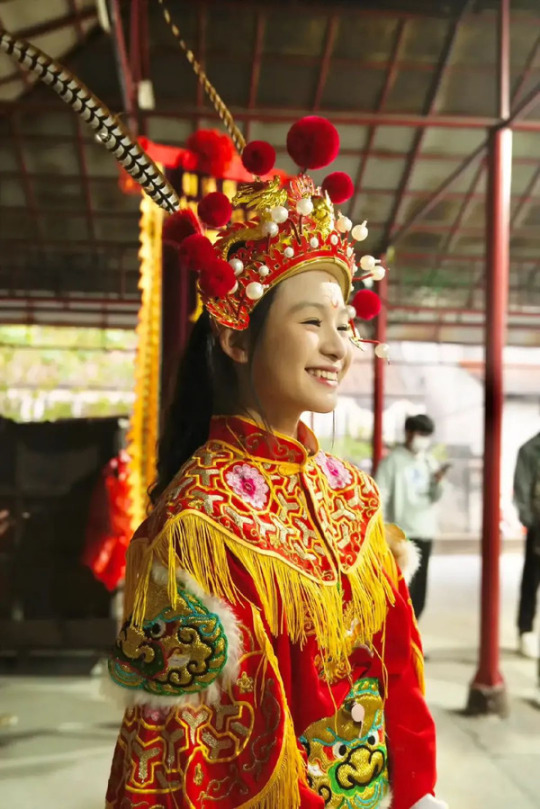

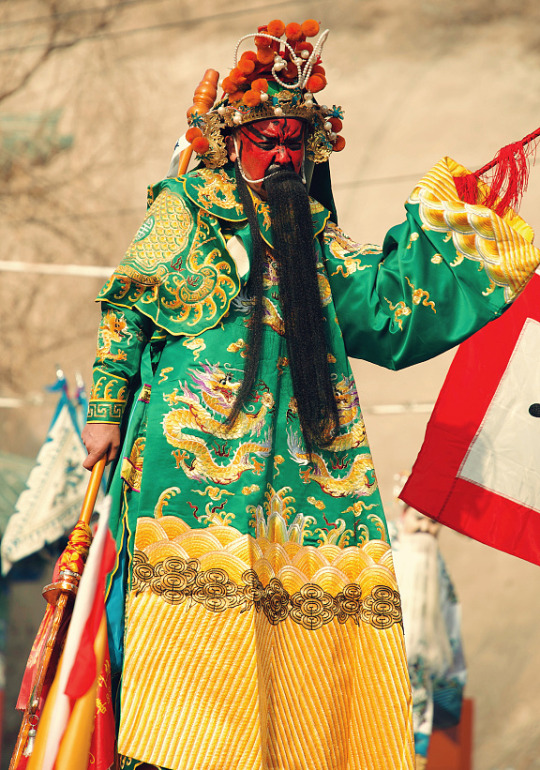
As a festive decoration, rongqiu was also widely used on bridal guan (crowns) from the Qing dynasty into the modern day.
Below - examples of rongqiu use in historical bridal guan: Left - a bride during the late Qing dynasty, circa 1890 (x); Right - a bride during the Republican era/minguo, in 1939 (x):
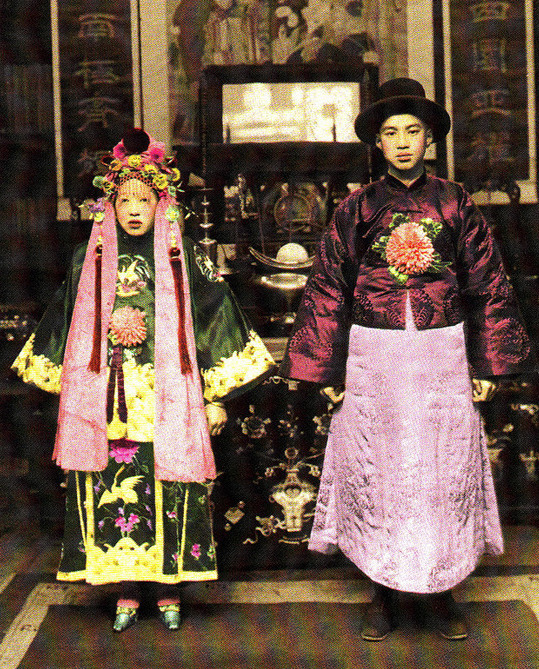
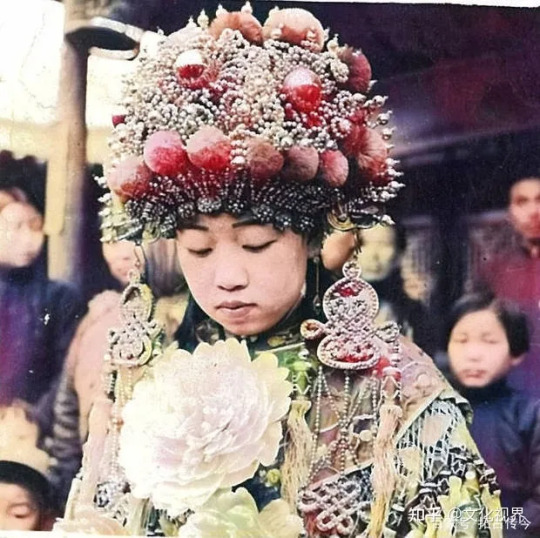
For some reason it's been extremely difficult to find sources on the origin of rongqiu that would shed more light on its significance, but based on historical paintings the use of rongqiu as a head ornament may have originated in the Qing dynasty. During the late Qing dynasty, it was fashionable among women to wear rongqiu on the sides of their hair, as can be seen in the paintings below (x):

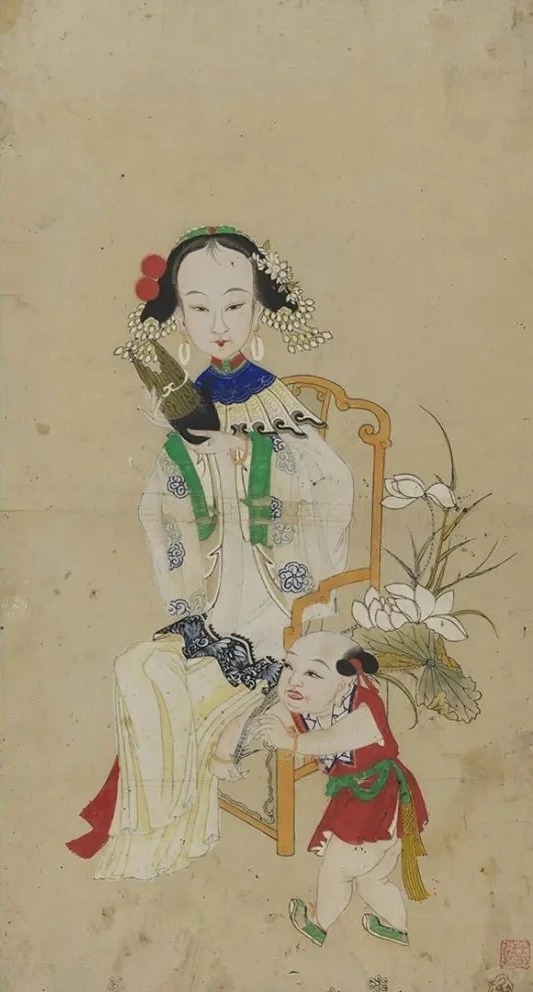
This particular style of rongqiu hair ornament was depicted in the 2012 historical cdrama 娘心计/Mother's Scheme:
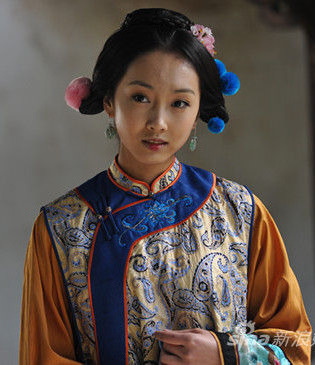
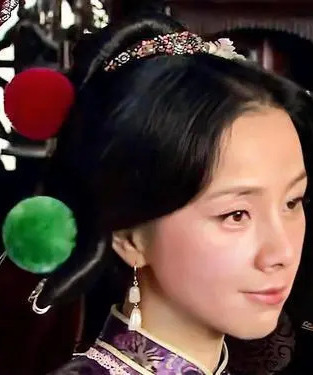
For more references, please see my rongqiu and kuitou tags.
If anyone has more information on the significance of rongqiu, please do share!
Hope this helps ^^
#rongqiu#pompoms#kuitou#chinese opera#opera costume#xifu#hanfu#history#reference#ask#reply#junpeicindystories#chinese fashion#chinese clothing#china
593 notes
·
View notes
Text
EXCLUSIVERICHARD EDEN: What the Queen REALLY thought of Meghan. My extensive research and Palace sources have unearthed troubling new questions about her and Harry's behaviour by u/Von_und_zu_
EXCLUSIVERICHARD EDEN: What the Queen REALLY thought of Meghan. My extensive research and Palace sources have unearthed troubling new questions about her and Harry's behaviour The headline is not very accurate. I did not see any "new questions" about the Unsussexfuls "behavior." Or new anything. This is, however, an entertaining summary of things that are already known, at least to Sinners.For example:However, as the couple prepared for their wedding, the Queen began having concerns about Meghan's behaviour and approach.First, she was said to be surprised that the new arrival rejected her suggestion that Prince Edward's wife, Sophie, offer her guidance on joining 'The Firm'.Her Majesty was also taken aback at the divorcee's choice of a white bridal gown for what was her second wedding - but it was Meghan's attitude towards her headwear that gave the Queen more serious cause for concern.She had offered Meghan access to her collection of tiaras and, during what Harry later described as an 'extraordinary morning', allowed her to try them on in front of her, her devoted dresser Angela Kelly and a royal jewellery expert in her private dressing room.Something later went badly wrong, however, when Meghan tried to arrange a fitting with Kelly, who, it seems, did not like the manner in which she was being treated by the bride and groom.Perhaps accustomed to ordering around underlings on a television shoot, Meghan may not have been used to dealing with someone such as Kelly, who - although a servant - was also a confidante and friend of the Queen.Harry denied in his memoirs, Spare, that he angrily told Kelly, 'What Meghan wants, Meghan gets.' He did, however, admit they had been exasperated by the dresser, who 'fixed me with a look that made me shiver'.https://ift.tt/qbeKzgS post link: https://ift.tt/nGHbAUu author: Von_und_zu_ submitted: November 21, 2024 at 02:13PM via SaintMeghanMarkle on Reddit disclaimer: all views + opinions expressed by the author of this post, as well as any comments and reblogs, are solely the author's own; they do not necessarily reflect the views of the administrator of this Tumblr blog. For entertainment only.
#SaintMeghanMarkle#harry and meghan#meghan markle#prince harry#fucking grifters#grifters gonna grift#Worldwide Privacy Tour#Instagram loving bitch wife#duchess of delinquency#walmart wallis#markled#archewell#archewell foundation#megxit#duke and duchess of sussex#duke of sussex#duchess of sussex#doria ragland#rent a royal#sentebale#clevr blends#lemonada media#archetypes with meghan#invictus#invictus games#Sussex#WAAAGH#american riviera orchard#Von_und_zu_
4 notes
·
View notes
Text
Price: [price_with_discount] (as of [price_update_date] - Details) [ad_1] Product Description DARKSTICK Fascinators Hats for Women Flower Mesh Ribbons Feathers on Headband Headwear Hair Clip for Party Wedding Halloween (Black) Elegant Design It comes with a vintage design with classic elements and modern detailing, making it a perfect fit for any dress code - its large size adds a touch of glamour to your outfit. Durable Material It is made with good grade lace material & artificial feather adornment that is durable and lightweight - has the right sturdiness to maintain its shape even after prolonged use. Easy to Wear Hair Clip The hair clip fascinator can simply be clipped on the hair, making it easy to wear, while its firm grip makes it stay in place all day, without tangling or pulling the hair. kentucky derby hats for women tea party hats fascinators hats for women tea party hats for women derby hats for women tea party hat derby hat kentucky derby outfits for women kentucky derby hats women's fascinators fascinators for tea party hat feathers fascinator headpiece feathers for hats party hat tea party hats for girls black fascinator hats for women tea hat feather headband hats for tea party fascinator headband tea hats black fascinator fascinators hats for women tea party fascinators for women tea hats for women women hats fashion hat bands for women fascinator hat bridal feather headdress pearl flower bow headwear feather derby hat feather fascinator flower fascinator black fascinators for women tea party fascinators for women kentucky derby mini top hat headband set victorian era dresses for women tea party fascinator hat hat accessories for women romantic organza fascinators headband hat fascinators for women tea party mesh veil headband feather hat band womens hats fashion black derby hats for women black feather headwear feather hair clips for women black top hat vintage womens hat feather mesh hat feather headbands black fascinators for women. Product Dimensions : 20 x 20 x 4 cm; 32 g Date First Available : 1 December 2023 ASIN : B0B5GKHJXT Item model number : Fascinators-Black
Department : Women Item Weight : 32 g Item Dimensions LxWxH : 20 x 20 x 4 Centimeters Generic Name : Fascinators [ad_2]
0 notes
Text
ELEGANT HAIR DECOR TO LOOK GORGEOUS
Beautiful things bring joy to the eyes and fulfilment to the mind. We all love to look pretty. It is not really difficult to make yourself look appealing when you choose your attire that suits you well. Additionally, the right accessories help to elevate any attire and make you look gorgeous.
Here are some ideas for hair decoration to make you stand out in the crowd.
FOREHEAD CHAIN:
It is the perfect accompaniment for any party or festive outfit. When you style yourself in a sparking and flowy outfit for a wedding or any event, the Exaggerated Head Chain Jewelery Boho Pearl, made of copper rhinestone, becomes a must-have accessory to let you shine bright. The forehead chain is a popular wedding accessory in India and other Asian countries.
TASSEL TIARA:
Dress up like a queen with the Tassel Headpieces Headdress Crystal Bohemian shining on your locks. It is a fun way to showcase your style and present your gorgeous self on any important occasion.
WEDDING HEADWEAR:
The classic white wedding gown and floral design headwear go hand in hand to give the most desired bridal look that every woman dreams of. Try putting on the 1Pcs Boho Style Handmade Faux Pearl Headwear that will never put you down at your wedding.
HAIR WIG
You may want to try different hairstyles for a refreshing new look, for which you need a good-quality hair wig. You may try long hair, short hair, curly or straight, in different colors. The Body Wave Lace Front Wigs Human Hair is just an example of the best quality natural wigs available for you.
CRYSTAL HEAD SCARF:
A lot can be changed in your look by replacing your regular scarf with the Luxury Rhinestone Head Scarf. It speaks out your fashion sense in a way that turns heads and draws admirers.
Which one would you try? https://finesseandstyle.com/
0 notes
Text
Pagdi for Wedding Near Me – Traditional Headwear for Special Day
Looking for a beautiful pagdi for wedding near me? Explore a wide range of traditional wedding pagdis that add a regal touch to your celebration. Find the perfect pagdi that complements your wedding attire and makes your day even more memorable. Discover local stores and online options offering stunning wedding pagdis to complete your bridal look.

0 notes
Text
Glamour Girlz is offering womens-beaded-diamante-crystal-encrusted-sparkly-1-5cm-wedding-formal-occasion-bridesmaid-christmas-birthday-pageant-evening-bridal-party-formal-alice-band-headwear-hairband-headband-pale-pink available at affordable Price.
Product Feature 1 : { Add sparkle and glamour to your hairstyle with crystal headbands from Glamour Girlz (www.glamourgirlz.co.uk)}
Product Feature 2 : { Our collection features intricately designed headbands that shimmer and shine, perfect for special occasions or everyday elegance }
Price :- £6.99 GBP
0 notes
Text
Random information about Bridal Wear for traditional Shinto Weddings:
*Note: I am in no way an expert on kimonos, so some of this might be wrong or inaccurately named. Really this is just me rambling about it.
The Ceremony | Hair:
- Traditionally, a woman would carefully wear her hair in a Japanese style (Nihongami) known as Bunkin Takashimada. In the modern era, this is usually a pre-styles wig rather than someone’s actual hair. However, You can get your actual hair styled into the Bunkin Takashimada - such as at the Atelier Iro in Kyoto, Japan. You can watch the process of styling the hair in this video by Q2Japan.
- To simplify the art of Nihongami, hair is primarily split into five sections. The bangs (maegami), the wings (bin), the bun/topknot (mage is the front, ichi is the back - usually just known entirely as the mage), and the hair at the nape of your neck - which is usually used to form a loop of hair below the topknot/bun (tabo or tsuto).
- An important part of the style is the Ne, or the base of the mage. This is because it supports the mage, bin, and tabo/tsuto. If it’s too tight, it will cause pain. If it’s too loose, you risk the hairstyle loosing its shape entirely.
- In the Bunkin Takashimada style specifically, the bin are styled to be full and rounded, and the maegami - pulled back from the face - is fuller as well. The mage is typically set high on the head, with the tabo being shorter but fuller compared to usual. However, specific styling - the shaping of the tabo, for example - differs from region or region in Japan.
- Like any other bride, the style is often accessorized with hairpins, combs, barrettes and many other articles, which are known as Kanzashi. There are a lot of types, and the style can also be divided by season - though, in the modern day, this rule of following the seasons is mostly followed by Geisha and Maiko.
Head Coverings:
- There are two traditional head coverings that a bride can wear for the Shinto Ceremony - The Wataboshi (cotton hood) and/or the Tsunokakushi (hiding horns). In the modern day, a bride typically chooses to wear one or the other, if not to simply wear neither.
Firstly, I’ll be going over the Wataboshi.
The Wataboshi (Lit: Cotton Hood):
- The Wataboshi is said to have originally been outdoors-wear, derived from the Katsuki - another headdress usually worn by married woman of samurai family in the Muromachi and Muromaya periods.
- It served to keep dust and grime generally off the hair, and could also keep away the cold in the chillier months.
- In the modern day, the Wataboshi functions most similarly to the western wedding veil. Due to its large size, it mostly obscures the face of the bride from view so that no one other than the groom can really see her until after the ceremony is over.
- Due to its white coloring, it’s generally and symbolically thought to represent purity, new beginnings, and so on - though, similarly to the Shiromuku (a type of kimono kimono) below, it can have a red lining.
- The Wataboshi itself is specifically worn only during the wedding ceremony, and only with the kimono worn for the ceremony - typically the shiromuku.
- Once the ceremony is over, the bride will remove the Wataboshi, and instead wear a different headpiece known as the Tsunokakushi to the reception if she wishes. She will also change from the Shiromuku into the more colorful brocaded kimono, the Iro-uchikake (see below).
- I’ll go into this more below, but according to one blog I read, some brides possibly used to actually wear the Tsunokakushi beneath the Wataboshi, tying to a different theory regarding their white coloring.
The Tsunokakushi (lit. Hiding the Horns)
- The second piece of bridal headwear, the Tsunokakushi, can be worn both during the wedding ceremony and during the reception. Unlike the Wataboshi, it can be worn with both the Shiromuku and Iro-uchikake.
- The Tsunokakushi is a rectangular, almost boat-like cloth that partially covers a bride’s hair. Typically, it’s made of white silk to match the white silk of the bride’s kimono. A bit similar to a Navy cap worn vertically, it peaks at both the front of the forehead, and in the back just behind the mage. There’s also usually a hole in the top of the Tsunokakushi, so that the mage remains uncovered and can be seen.
- Traditionally, it is accepted that the Tsunokakushi is worn to hide or prevent horns from growing on the head of the bride, as an old folktale spoke of woman turning into demons from jealousy. It also has been said that it symbolizes obedience to her spouse. Essentially, it suppresses dark and negative lines of thought.
- The theory I mentioned above hypothesized that it actually represents the underworld, not just being meant to hide the horns of the bride. It ties to the Wataboshi and Tsunokakushi being worn at the same time.
- The Tsunokakushi is thought to have rose to prominence during the Edo-period as a sort of headdress women would wear when inside Buddhist temples. In some sects of Buddhism, women were expected to cover their hairlines in front (widow’s peak, I think?), traditionally shaved off in men’s fashion.
- In other words, there’s a lot of debate over the etymology and origin.
The Ceremony: The Kimonos
Traditionally speaking, a bride wears two (?) types of kimono.
For the ceremony itself, the padded shiromuku is worn atop a lighter kakeshita (a type of furisode kimono. I think hon-furisode? except the collar and hem is padded). Though, she may choose wear the more colorful iro-uchikake instead.
Following the ceremony, the bride may then change into the Iro-Uchikake (if she wasn't already wearing one, so I've split them apart in this post)
She may also simply forgo the uchikake entirely, either displaying the furisode she was wearing or changing into a different furisode-style kimono (hiki-furisode, usually) for the reception.
The General Kimono Undergarments:
The silhouette of the kimono isn't focused on curves of the body, the way western clothing styles did/do. It's a more smooth, cylindrical shape instead. This leads to different sort of undergarments to preserve the shape of the kimono.
When people wore them, they didn't wear bras or panties/boxers that go under modern western style clothing - or, not in the same way.
Instead, the hadagi - also known as the hadajuban - was worn. Usually made from cotton, this can either be a one piece garment or divided into a top shirt and a skirt known as susuyoke, though this can also be replaced by trousers, etc. The hadagi usually has cord attached that is used to tie it shut/secure it in place. Just like the rest of kimono wear, it is folded left over right.
Traditionally, this goes directly on your skin and nothing is worn underneath (though I think in modern day you can wear kimono bras to smooth out your bust, and in the past woman used Sarashi as bindings instead).
If you require it, hoseigi - kimono padding - is added atop to hadagi to fill out the space, making the rounded shape of the kimono firmer, fuller. (Using it depends on the occasion, individual need and comfort, etc).
Over top that, the juban is worn.
This could be either the nagajuban - a one-piece originally having been an essential garment in a woman's kimono wardrobe, but also very common for men to wear today - or the hanjuban, which in contrast is made of two pieces.
Regardless of which type of juban you wear, unlike the hadagi, it has a thick collar referred to as the han-eri, which is meant to be seen above the collar of the actual kimono. This can either be sewn on, or just pinned in place.
The han-eri is akin to a boning channel, in that usually most people will put a collar stiffener called the erishin through it. In the modern day, it's usually plastic, but it can also be made out of paper.
The juban is tied shut with a fabric tie called the himo. This is usually around the waist of the juban, and is also used to tie the kimono shut (the koshihimo around the waist and then the munahimo just below the chest).
In the modern day, elastic korin belts can be used in place of himo ties, as their flexibility makes them more comfortable, and the clips at each end are more manageable than tying them off.
The juban can also be tied shut with broader ties, such as the datemaki.
There are a lot more options for kimono undergarments, but the differences between names and roles goes a bit over my head, so these are (for me) the simplest ones to understand.
(Billy Matsunaga's channel is great for understanding the structure of the kimonos and how to wear them in general, and a video by PaprikaGirl shows how one gets dressed in a kimono).
The Shiromuku & Kakeshita:
In many weddings, when a bride wears a shiromuku kimono, she's often wearing several kimonos - the shiro-kakeshita kimono, and then the uchikake over top. Possibly more, depending on whether or preference?
The term 'shiromuku' actually refers to the upper kimono, the uchikake. It's an extremely formal kimono worn as outerwear - I've heard it likened to a coat once, so it's never actually tied shut by an obi -> the kimono below it is.
It's constructed to be very thick, being heavily padded at the hem to prevent wear. This is because the shiromuku isn't tied shut. Where as the kakeshita below would be tied with both the himo and obi after being lifted up so as not to drag on the floor, and the excess bagginess folded over to hide the himo - the shiromuku isn't.
As a result, it's much longer that the kimono/kimono undergarments and intended to drag along the floor when indoors.
Traditionally, the uchikake is purely white, and therefore referred to as the shiro-uchikake. It's just more commonly called shiromuku.
In comparison, the kakeshita isn't so heavily padded at the hem, and it is thinner then the shiromuku kimono - and as I mentioned, it is the kakeshita which is tied shut with both the himo and obi.
(According to a series of rabbit holes I went down, as I mentioned earlier, the kakeshita kimono is bridal variant of the hon-furisode. Furisode kimono are known for their long sleeves and usually only worn by unmarried woman, the hon-furisode being the most formal with sleeves around 114 cm in length.)
The Iro-Uchikake:
As mentioned above, the Shiromuku kimono a bride typically wears is a white uchikake. In comparison, the iro-uchikake, though similar in padded design, are vibrantly colored with dyes and embroidery instead.
Accessories:
After the bride has been dressed in shiromuku (or iro-uchikake), traditionally she will have three primary accessories tucked into her clothing to carry during the ceremony.
The Hakoseko:
The hakoseko is a small box-like container, though I've also heard it called a folding purse or wallet. It has a very practical purpose in that the hakoseko holds the cosmetics of the bride - though, usually it's more symbolic than anything else in the modern day. Originally it was made of folded paper.
Inside, there's often a comb and mirror set, as well as lipstick. It may also carry lucky charms. This was used for any touch-ups needed for the bride's appearance, and also represents her will to maintain her beauty.
This is tucked into the han-eri (collar) of the bride's kimono.
The Kaiken/Futogorogatana:
A kaiken small blade given to the bride, often tucked into her obi. It's meant to be used to protect her home and self - or to commit suicide if necessary. In the past, these were carried in brocade pouches for easy access, and for weddings they're usually decorated with tassles of some sort, meant to hide the daggers.
The Sensu/Suehiro:
The sensu/suehiro (i haven't yet figured the difference between the two terms, though I think it pertains to shape) is a fan carried by the bride. It's said to symbolize the happiness of the couple - growing larger over time.
Wedding Death Theory:
In Japan, the color white can mean two things: Purity and Death.
I think it's less directly related to death, and more the fact that the dead are dressed in white kimono prior to cremation or burial. Still, the connection sticks.
The death/underworld theory I've mentioned is that, in taking on her husband's family name, the bride herself had 'died'. Though putting on the tsunokakushi and wataboshi headress is still tied to repressing more negative emotions - it also signalizes resurrection from the dead, re-entering the human world.
SOURCES
https://kimurakami.com/blogs/japan-blog/kimono
https://shop.japanobjects.com/blogs/editorial/japanese-kimono?srsltid=AfmBOop9UpgSSgamaLBSJeFUrhXrzjVkiYVkEiU41EUU7hRN5o9_4A-7
https://shop.japanobjects.com/blogs/editorial/kimono-types
https://imgur.com/gallery/introduction-to-kimono-types-4vEkAHc
https://livinginjapan.net/2020/04/00516/
https://www.tsunagujapan.com/10-different-types-of-kimono-for-women/
https://members.tripod.com/wonderful_weddings/tsukikajiphotoalbum/id11.html
BRIDAL KIMONO:
https://luckyricefield.wordpress.com/2016/01/21/the-truth-behind-the-white-wedding-kimono/#:~:text=The%20%E2%80%9Ctsunokakushi%E2%80%9D%20used%20to%20actually,the%20removal%20of%20the%20horns.
https://myjapanslice.com/2016/10/31/attending-a-traditional-wedding-in-japan-the-ceremony/
https://www.es-kyoto.yumeyakata.com/single-post/20180325
https://www2.northwestmuseum.org/museum/detail-traditional-japanese-wallet-hakoseko-57219.htm
http://maihanami.blogspot.com/2016/01/kimono-q-wedding-kimono.html?m=1
http://kyoto-weddings.jp/bridalkimono.html
https://japandreamwedding.com/cultural-information/womens-traditional-wedding-ensembles/
Difference between Furisode & Hiki-Furisode
https://iwabijin.wordpress.com/2016/01/29/the-transformation-of-a-frisode/
Bridal Accessories
https://www.amazon.com/DEAR-VANILLA-Authentic-Traditional-Accessory/dp/B0DCWJFQ7Y#:~:text=Hakoseko%20is%20a%20wallet%2Dlike,in%20matching%20color%20or%20patterns.
PLUS - a screenshot of videos I've watched.
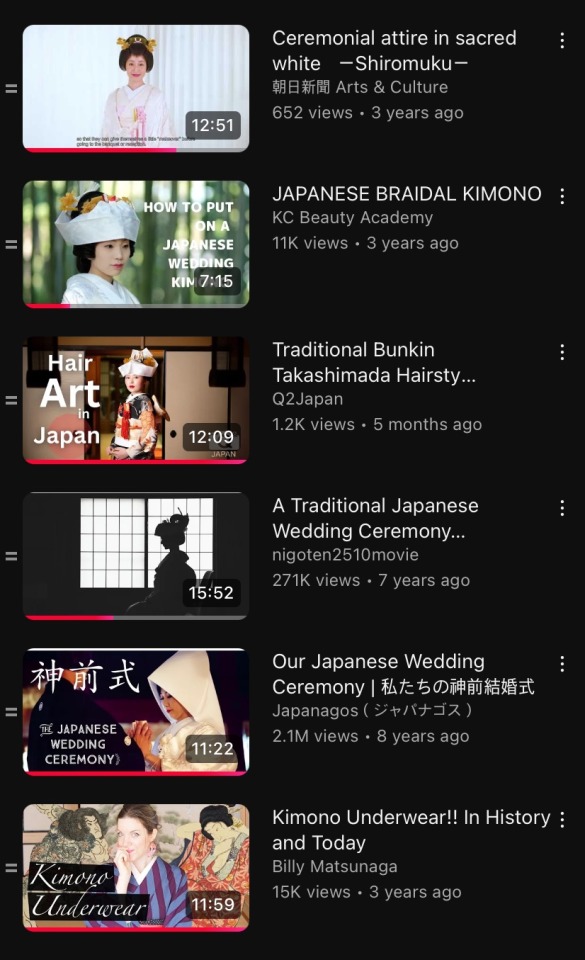
#this post was brought to you by both ffxv and umineko#kind of scattered all over the place but this isn't mean to be educational#wedding wear for writing stuff#there is so much stuff i didn't put into this post it's not funny but my brain is fried#and this has been sitting in my drafts for literal months#I'm pretty sure I'm missing a few sources and I'm so sorry for that
0 notes
Video
youtube
✨ Embrace your inner goddess with our stunning Hollow Round Crystal Hair Chain Hat! ✨ This ethereal piece effortlessly merges boho vibes and vintage elegance, making you the star of every special occasion. Whether you're walking down the aisle or dancing the night away, the dazzling rhinestones and flowing tassels will add just the right touch of magic to your look! 💖👰🏼✨ Get ready to shine brighter than ever! 🌟#BridalHeadwear #BohoChic #WeddingJewelry #FlapperStyle #RhinestoneHairAccessory #TasselHeadpiece #CrystalHairChain #BridalAccessories #VintageVibes #DazzlingBride #kimludcom💃✨💄🤩 #kimludcom #viral #viralvideo #viraltiktok Shop Now https://www.kimlud.com/products/hollow-round-crystal-hair-chain-hat-bridal-headwear-for-women-boho-flapper-cap-rhinestone-tassel-headpiece-wedding-jewelry
0 notes
Text
Reflective Romance: How to Choose the Perfect Mirrored Wedding Gown
Hey there, fashion-forward brides-to-be!
If you're looking to make a bold statement on your wedding day, look no further than the mirrored wedding gown trend.
It's a dazzling departure from the traditional white dress, promising to make you the star of your own show.
As a master tailor with over three decades of experience in the fashion world, I've seen this trend take off and I'm here to guide you through every shimmering step.
Embracing the Reflective Romance
Remember those disco balls from the 70s?
Think of them as the inspiration behind this modern bridal fashion phenomenon.
Mirrored gowns are a celebration of individuality, confidence, and a love for all things that sparkle.
They're the perfect choice for the bride who isn't afraid to break tradition and embrace her unique style.
But don't worry, these gowns aren't just for disco divas.
From subtle shimmer to all-out sparkle, there's a mirrored gown out there for every bride's personality and wedding theme.
Whether you're envisioning a beach wedding, a formal affair, or something in between, a mirrored gown can be tailored to your taste and vision.

Mirrored Wedding Dress Styles: A Kaleidoscope of Choices
Let's talk styles!
The versatility of mirrored gowns is what makes them so exciting.
Sleek and Modern:
For the minimalist bride, a simple slip dress in silver or gold mirrored fabric exudes effortless chic. I
t's perfect for a city wedding or an intimate ceremony where less is more.
Disco Glam:
If you want to make a statement, go all out with a fully mirrored gown covered in sequins or mosaic tiles.
This style is for the bride who loves to dance and wants to make a lasting impression.
Geometric Goddess:
Modern art meets bridal fashion in mirrored gowns with geometric patterns.
These unique designs are perfect for the fashion-forward bride who isn't afraid to take risks.
Ethereal Elegance:
Dreaming of a romantic look?
A mirrored gown with flowing fabrics like chiffon or tulle is the answer.
The soft movement of the fabric combined with the shimmering mirror effect creates pure magic.
Touch of Sparkle:
If you want to hint at the trend, consider a dress with mirrored accents.
A mirrored belt, a shimmering bodice, or delicate beading can add just the right amount of sparkle.
Finding Your Perfect Fit: Matching Your Body Type and Style
The right mirrored gown should not only match your personal style but also flatter your figure.
Here's how to find your perfect match:
Know Your Body Shape:
Whether you're an hourglass, pear, apple, rectangle, or inverted triangle, certain silhouettes will complement your shape better than others.
For instance, A-line gowns are universally flattering, while mermaid styles accentuate curves.
Consider Your Style:
Are you a boho bride, a minimalist, or drawn to classic elegance?
Your gown should reflect your personal style.
Boho brides might love a flowy gown with vintage-inspired details, while minimalists could opt for a sleek, simple silhouette.
Don't Forget Alterations:
Even if you find a gown you love, a skilled tailor can make it truly yours.
They can adjust the fit, hem the length, or even add custom details like a mirrored belt or straps.
Accessorizing Your Reflective Romance
The right accessories can elevate your mirrored gown from stunning to spectacular.
However, it's important to strike a balance and not overshadow the main attraction - your dress!
Headwear:
A simple, sparkling headband or a few scattered crystal hairpins can add a touch of glamour.
A floral crown with metallic accents is perfect for a boho vibe.
Jewelry:
Opt for understated earrings and a delicate necklace to complement your gown's sparkle.
If your dress is strapless or sleeveless, a bracelet or cuff can add a touch of sophistication.
Shoes:
Metallic heels are a natural choice for a mirrored gown, but don't be afraid to experiment with embellished sandals or even classic white or neutral shoes if you want the dress to be the main focus.

Where to Buy Your Dream Dress
Ready to start your search?
Here are some options to consider:
Designer Boutiques:
Many high-end designers are embracing this trend, creating unique and stunning mirrored gowns.
Online Retailers:
You can find a wide variety of styles and price points online, from affordable options to designer pieces.
Sample Sales and Trunk Shows:
These events offer a great opportunity to snag a designer gown at a discounted price.
Custom Design:
If you have a specific vision in mind, consider working with a designer or tailor to create a bespoke mirrored gown that's truly one-of-a-kind.
Inspiration for Every Bride
No matter your style, there's a mirrored gown out there for you.
Let your imagination run wild!
Beach Wedding:
Imagine a lightweight, flowing gown with subtle mirrored accents, paired with loose waves and a flower crown.
Formal Affair:
A structured gown with a dramatic train and all-over mirror embellishments will make you feel like royalty.
Boho Chic:
Choose a vintage-inspired gown with delicate lace, flowing sleeves, and mirrored beading.
Minimalist:
A sleek, minimalist gown in a shimmering fabric will exude modern elegance.
Conclusion: Let Your Light Shine
A mirrored wedding gown is a bold choice, but it's also a beautiful one.
It's a chance to express your individuality, embrace your confidence, and shine brightly on your special day.
So go ahead and let your light shine, brides!
FAQs
Q: Are mirrored wedding gowns appropriate for all venues?
A: Absolutely! It depends on the style of the dress and the venue's atmosphere, but with the right choice, a mirrored gown can look stunning in any setting.
Q: What kind of undergarments should I wear with a mirrored wedding gown?
A: Opt for seamless undergarments in nude or a color that matches your skin tone to avoid any visible lines.
Q: Can I alter a mirrored wedding gown?
A: Yes, most alterations are possible with mirrored gowns, but it's essential to work with a skilled tailor who has experience with delicate fabrics.
Q: How do I care for a mirrored wedding gown?
A: Store it in a cool, dry place away from direct sunlight, and take it to a professional cleaner specializing in delicate fabrics after the wedding.
Q: Where can I find mirrored wedding gowns?
A: You can find them at designer boutiques, online retailers, sample sales, and even some local bridal shops. You can also have a custom gown made by a designer or tailor.
I hope this guide has been helpful in your quest for the perfect mirrored wedding gown.
Remember, the most important thing is to choose a dress that makes you feel confident and beautiful.
Happy wedding planning!
https://www.ellasalterations.com/2024/07/27/reflective-romance-how-to-choose-the-perfect-mirrored-wedding-gown/

#fashion#wedding#formal#pageant#prom#EllasAlterationsLLC#mirroredweddinggown#reflectiveweddingdress#weddingdressgoals#weddinginspo#bridalfashion#weddingtrends#modernbride#uniqueweddingdress#statementdress#discoballbride#shimmeringbride#weddingstyle#bridalstyle#fashionforwardbride#nontraditionalwedding#alternativebride#weddingdaylook#weddingfashion#bridetobe#engaged#weddingplanning#realwedding#weddingphotographer#weddinginspiration
0 notes
Text
The Role of Jewellry in Cultural Traditions
Jewellry touches every culture for hundreds of years. More than just pretty, jewellry often means more. It shows status, money, faith, and important life events. We'll look at how different cultures use jewellry. We'll see why it's so important to them.
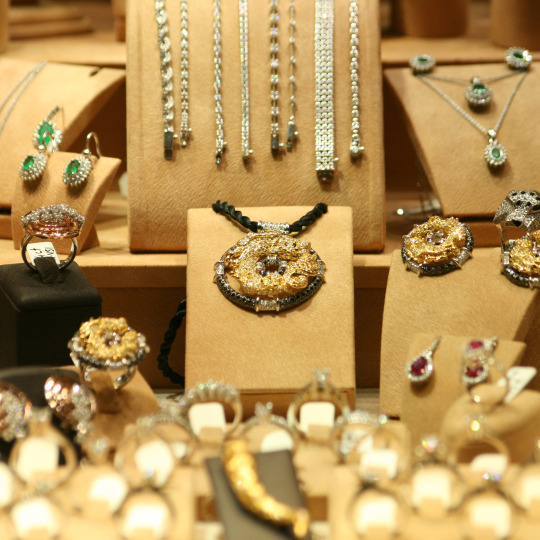
The Story of African Beadwork:
More Than Art: Beads are not merely for decoration across African societies. They hold significant meaning, expressing identity, standing, and dialogue. Take, for example, the Maasai community from Kenya and Tanzania. They cleverly use vibrant beads to represent various social aspects. What the beads look like and what shades they are can hint at if someone is married, how old they are, and where they stand socially in the tribe.
Indian Bridal Jewellry: Not Just Pretty, But Meaningful:
Indian bridal jewellry is more than just decoration. It's part of the wedding and stands for good fortune, charm, and safety. Every item is important, from the maang tikka on the bride's forehead to the payal on her feet. The mangal sutra necklace is another crucial piece. The groom ties it during the ceremony. It shows that the bride is married and is thought to keep the marriage safe from harm.
Jade Pieces from China: A Snapshot of Goodness and Righteousness:
Loved for millennia in China, jade is a symbol of pure beauty, elegance, and solid morals. Jade ornaments like bracelets and charms are popular gifts, representing well-wishes and safety. It's also thought to keep harm far and bring equilibrium and unity to the life of the one wearing it.
Heirloom Jewells in Europe: Linking Past and Present:
In various European societies, jewells frequently find their way from one generation to the next, preserved as family treasures. These items hold value not just from their skillful crafting and high-quality materials, but also from the family tales and remembrances they enshrine. Wearing these heirloom jewells during notable events pays homage to forebears while affirming the family's ongoing bond and lineage.
Gold in the Middle East: A Sign of Wealth and Standing:
Gold trinkets in Middle Eastern traditions are a vivid sign of luxury and social standing. They are commonly part of wedding dowries, signifying the family's affluence. The detailed patterns on Middle Eastern gold trinkets mirror the vibrant cultural legacy and artistic customs of the area. Gold trinkets are also viewed as a safe asset and a type of financial safety.
The Art of Kintsugi: Honoring the Broken:
Kintsugi emerges from Japan. It's a method that mends shattered pottery using a blend of lacquer and precious metal dust such as gold, silver, or platinum. The same technique also applies to jewellry. This process underscores the appeal of flaws and champions repair over disposal. As a symbol, Kintsugi jewellry communicates grit, evolution, and the charm of faultiness. It mirrors the Japanese mindset of wabi-sabi.
Shell Accessories of Pacific Islanders: A Link to Earth and Heritage:
Shell adornments in plenty of Pacific Island societies signify a profound bond with nature and lineage. These shells are transformed into various items such as necklaces, earpieces, and ornamental headwear, representing the crucial role the sea plays in their existence. Often, these articles act like protective charms, creating a spiritual connection between the wearer, their forefathers, and the environment.
Conclusion:
Jewellry holds a special spot in many cultures, standing for more things than just aesthetics. From the detailed African bead designs, and India's meaningful wedding gems, to the sacred turquoise of Native Americans, each piece carries a tale of culture, lineage, and principles. Recognizing what jewellry means culturally lets us see its actual worth and the deep customs it showcases.
0 notes
Text
Transcript below the cut.
三更天 喜乐喧天 灵堂变喜堂 鬼新娘 红花绿线 喜堂变灵堂 招魂幡 阴风飘飘 有人念有人烧 白喜丧 凤冠霞帔 纸钱化灰空飘 飘 纸人俏 纸马高 月儿照 逢人笑 纸人跳 抬花轿 月儿照 逢人笑
招魂幡 阴风飘飘 有人念有人烧 白喜丧 凤冠霞帔 纸钱化灰空飘 飘 飘 飘 飘
纸人俏 纸马高 月儿照 逢人笑 纸人跳 抬花轿 月儿照 逢人笑
嫁殇 嫁殇 嫁殇 嫁殇
Midnight, (Note: Archaic phrase, based on the olden system of telling time.) A joyful clamor rings through the air, The funeral hall has been transformed into a wedding hall, A ghost bride Red flowers and green string, (Note: Red and green were common color pairings for Chinese weddings in olden times.) The wedding hall has been transformed into a funeral hall, A spirit-attracting banner, (Note: Now used primarily at funerals, they were also formerly used for various other rituals or occasions where departed spirits required summoning.) A sinister wind blows, Someone chants and someone burns, (Note: Burns offerings, such as ritual paper money for the dead.) A white celebration, (Note: White is the color of funerals in Chinese culture. “喜丧”, “joy mourning”, is a funeral that is conducted as a celebration.) A phoenix crown and xiapei, (Note: a type of hanfu headwear and outerwear/ribbon that are traditionally worn by brides since Song times.) Ritual burning money turns to ash and flutters in the air, It flutters
The paper doll is attractive, the paper horse is tall, The moon shines, witnesses laugh, The paper doll hops, the bridal sedan chair is lifted, The moon shines, witnesses laugh
A spirit-attracting banner, A sinister wind blows, Someone chants and someone burns, A white celebration, A phoenix crown and xiapei, Ritual burning money turns to ash and flutters in the air, It flutters, it flutters, it flutters, it flutters
The paper doll is attractive, the paper horse is tall, The moon shines, witnesses laugh, The paper doll hops, the bridal sedan chair is lifted, The moon shines, witnesses laugh
Marry and mourn, marry and mourn, marry and mourn, marry and mourn
嫁殇 (Marry and Mourn) by 椿乐队.
A 嫁殇 (jià shāng) is a Chinese tradition in olden times of either holding a marrying-off ceremony for a woman who died young after already receiving a betrothal gift, or it refers to a ghost wedding for individuals who are already dead (so they can be considered buried together and their families can be joined).
English added by me :)
402 notes
·
View notes
Link
Check out this listing I just added to my Poshmark closet: (Bridal) ZHENGJIALI Imitation Flower Hoop Fairy Garland Earrings Set Headwear.
0 notes
Text
Unveiling the Essence of Elegance: Finding the Best Wedding Planner in Kolkata
Nestled amidst the vibrant tapestry of Kolkata, Euphoria Wedding emerges as the epitome of excellence in the realm of wedding management. With decades of invaluable experience, we have proudly earned the esteemed title of the best wedding planner in Kolkata, dedicated to crafting seamless and unforgettable celebrations for our cherished clients.

As the top wedding planner in Kolkata, Euphoria Wedding prides itself on its unwavering commitment to professionalism and perfection. Our team comprises seasoned professionals and industry experts, each meticulously chosen to ensure that every aspect of your special day is handled with the utmost care and precision. We understand the significance of your wedding day, and our primary objective is to transform your dreams into a breathtaking reality.
Comprehensive Wedding Planning Excellence
At Euphoria Wedding, we specialize in innovative and contemporary wedding formats, setting us apart as a leading wedding management company in Kolkata. Our comprehensive approach covers every aspect of your celebration, offering you a hassle-free and unforgettable wedding experience.
Tailored Services to Exceed Expectations:
Budgeting: We prioritize financial planning to ensure your dream wedding fits within your budget constraints.
Venue Selection: Choose from our curated list of exquisite venues that align perfectly with your vision and preferences.
Decoration: Our skilled team of designers will transform your chosen venue into a mesmerizing space that reflects your unique style.
Wedding Attire: From the bridal gown to the attire of your loved ones, we ensure everyone looks their absolute best.
Traditional Elements: We meticulously select traditional headwear and incorporate cultural rituals to add richness and authenticity to your ceremony.
Culinary Delights: Indulge in a culinary journey curated to delight the taste buds of your guests, offering a diverse range of exquisite dishes.
Photography & Videography: Capture every precious moment with our talented photographers and videographers, preserving memories that will last a lifetime.
Beauty & Makeup: Our experienced makeup artists will enhance your natural beauty, ensuring you look radiant on your special day.
Entertainment: From music to dance performances, we curate entertainment that adds joy and excitement to your celebration.
Invitation & Hospitality: Impress your guests with elegant invitations and impeccable hospitality, ensuring a warm and welcoming atmosphere.
Trousseau Services: We offer assistance in selecting and packing your trousseau with care and elegance, ensuring you're well-prepared for your new journey.
Legal & Ritualistic Support: Navigate through legalities and traditional rituals seamlessly, with our expert guidance and support.
Class, Elegance, and Affordability Combined:
Euphoria Wedding is more than just a wedding management company; it's a symbol of class, elegance, and affordability. We take pride in making our clients' dreams our own, ensuring that every detail of their special day reflects their unique style and preferences.
Conclusion:
For a best destination wedding planner in Kolkata that surpasses expectations and a marriage event management company in Kolkata committed to perfection, choose Euphoria Wedding. Let us create a wedding experience that exceeds your wildest dreams and leaves an everlasting impression on your memories. Choose Euphoria Wedding – Where Perfection Meets Celebration!
For More Details :-
Best Wedding Planner in Kolkata
The Euphoria Wedding
Address- 8/1 Nandi Bagan Road Kolkata 700078
Gmail - [email protected]
Phone No. - +91 6290086705/ +91 6290097523
Website-www.theeuphoriawedding.com
#wedding management company in kolkata#best wedding planner in kolkata#marriage event management company in kolkata#top wedding planner in kolkata#best destination wedding planner in kolkata#wedding photography
0 notes






